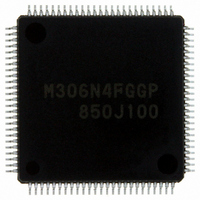M306N4FGGP#U3 Renesas Electronics America, M306N4FGGP#U3 Datasheet - Page 381

M306N4FGGP#U3
Manufacturer Part Number
M306N4FGGP#U3
Description
IC M16C/6N4 MCU FLASH 100-LQFP
Manufacturer
Renesas Electronics America
Series
M16C™ M16C/6Nr
Specifications of M306N4FGGP#U3
Core Processor
M16C/60
Core Size
16-Bit
Speed
24MHz
Connectivity
CAN, I²C, IEBus, SIO, UART/USART
Peripherals
DMA, WDT
Number Of I /o
85
Program Memory Size
256KB (256K x 8)
Program Memory Type
FLASH
Ram Size
10K x 8
Voltage - Supply (vcc/vdd)
3 V ~ 5.5 V
Data Converters
A/D 26x10b; D/A 2x8b
Oscillator Type
Internal
Operating Temperature
-40°C ~ 85°C
Package / Case
100-LQFP
Package
100LQFP
Family Name
M16C
Maximum Speed
24 MHz
Operating Supply Voltage
3.3|5 V
Data Bus Width
16|32 Bit
Number Of Programmable I/os
87
Interface Type
I2C/UART
On-chip Adc
26-chx10-bit
On-chip Dac
2-chx8-bit
Number Of Timers
11
For Use With
R0K3306NKS001BE - KIT DEV RSK RSK-M16C/6NKR0K3306NKS000BE - KIT DEV RSK RSK-M16C/6NK
Lead Free Status / RoHS Status
Lead free / RoHS Compliant
Eeprom Size
-
Available stocks
Company
Part Number
Manufacturer
Quantity
Price
- Current page: 381 of 414
- Download datasheet (3Mb)
M16C/6N Group (M16C/6N4)
Rev.2.40
REJ09B0009-0240
23.9 Serial Interface
23.9.1 Clock Synchronous Serial I/O Mode
23.9.1.1 Transmission/reception
23.9.1.2 Transmission
23.9.1.3 Reception
With an external clock selected, and choosing the RTS function, the output level of the RTSi pin goes to
“L” when the data-receivable status becomes ready, which informs the transmission side that the reception
has become ready. The output level of the RTSi pin goes to “H” when reception starts. So if the RTSi pin
is connected to the CTSi pin on the transmission side, the circuit can transmission and reception data
with consistent timing. With the internal clock, the RTS function has no effect.
If a low-level signal is applied to the NMI pin when the IVPCR1 bit in the TB2SC register = 1 (three-phase
output forcible cutoff by input on NMI pin enabled), pins RTS2 and CLK2 go to a high-impedance state.
When an external clock is selected, the conditions must be met while if the CKPOL bit in the UiC0
register = 0 (transmit data output at the falling edge and the receive data taken in at the rising edge of the
transfer clock), the external clock is in the high state; if the CKPOL bit = 1 (transmit data output at the
rising edge and the receive data taken in at the falling edge of the transfer clock), the external clock is in
the low state.
• The TE bit in the UiC1 register = 1 (transmission enabled)
• The TI bit in the UiC1 register = 0 (data present in UiTB register)
• If CTS function is selected, input on the CTSi pin = L
In operating the clock synchronous serial I/O, operating a transmitter generates a shift clock. Fix settings
for transmission even when using the device only for reception. Dummy data is output to the outside
from the TXDi (i = 0 to 2) pin when receiving data.
When an internal clock is selected, set the TE bit in the UiC1 register (i = 0 to 2) to 1 (transmission
enabled) and write dummy data to the UiTB register, and the shift clock will thereby be generated. When
an external clock is selected, set the TE bit to 1 and write dummy data to the UiTB register, and the shift
clock will be generated when the external clock is fed to the CLKi input pin.
When successively receiving data, if all bits of the next receive data are prepared in the UARTi receive
register while the RI bit in the UiC1 register = 1 (data present in the UiRB register), an overrun error
occurs and the OER bit in the UiRB register is set to 1 (overrun error occurred). In this case, because the
content of the UiRB register is undefined, a corrective measure must be taken by programs on the
transmit and receive sides so that the valid data before the overrun error occurred will be retransmitted.
Note that when an overrun error occurred, the IR bit in the SiRIC register does not change state.
To receive data in succession, set dummy data in the lower-order byte of the UiTB register every time
reception is made.
When an external clock is selected, the conditions must be met while if the CKPOL bit = 0, the external
clock is in the high state; if the CKPOL bit = 1, the external clock is in the low state.
• The RE bit in the UiC1 register = 1 (reception enabled)
• The TE bit in the UiC1 register = 1 (transmission enabled)
• The TI bit in the UiC1 register = 0 (data present in the UiTB register)
Apr 14, 2006
_______
page 357 of 376
________
_______
_______
________
________
_______
_______
_________
________
23. Usage Notes
________
Related parts for M306N4FGGP#U3
Image
Part Number
Description
Manufacturer
Datasheet
Request
R

Part Number:
Description:
KIT STARTER FOR M16C/29
Manufacturer:
Renesas Electronics America
Datasheet:

Part Number:
Description:
KIT STARTER FOR R8C/2D
Manufacturer:
Renesas Electronics America
Datasheet:

Part Number:
Description:
R0K33062P STARTER KIT
Manufacturer:
Renesas Electronics America
Datasheet:

Part Number:
Description:
KIT STARTER FOR R8C/23 E8A
Manufacturer:
Renesas Electronics America
Datasheet:

Part Number:
Description:
KIT STARTER FOR R8C/25
Manufacturer:
Renesas Electronics America
Datasheet:

Part Number:
Description:
KIT STARTER H8S2456 SHARPE DSPLY
Manufacturer:
Renesas Electronics America
Datasheet:

Part Number:
Description:
KIT STARTER FOR R8C38C
Manufacturer:
Renesas Electronics America
Datasheet:

Part Number:
Description:
KIT STARTER FOR R8C35C
Manufacturer:
Renesas Electronics America
Datasheet:

Part Number:
Description:
KIT STARTER FOR R8CL3AC+LCD APPS
Manufacturer:
Renesas Electronics America
Datasheet:

Part Number:
Description:
KIT STARTER FOR RX610
Manufacturer:
Renesas Electronics America
Datasheet:

Part Number:
Description:
KIT STARTER FOR R32C/118
Manufacturer:
Renesas Electronics America
Datasheet:

Part Number:
Description:
KIT DEV RSK-R8C/26-29
Manufacturer:
Renesas Electronics America
Datasheet:

Part Number:
Description:
KIT STARTER FOR SH7124
Manufacturer:
Renesas Electronics America
Datasheet:

Part Number:
Description:
KIT STARTER FOR H8SX/1622
Manufacturer:
Renesas Electronics America
Datasheet:

Part Number:
Description:
KIT DEV FOR SH7203
Manufacturer:
Renesas Electronics America
Datasheet:











